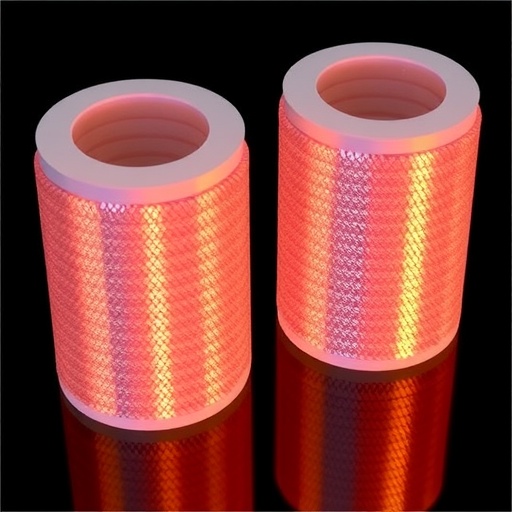In the ever-evolving landscape of energy storage technologies, researchers have dedicated extensive efforts to developing materials that fulfill the increasing demand for efficient and sustainable energy solutions. A recent breakthrough demonstrated by a team of scientists highlights the potential of coaxial-like FeS/MoS₂@C composites for sodium storage performance. The innovative preparation of these composites through an electrospinning-calcination method promises to revolutionize the current paradigms in sodium-ion battery technology.
The study, carried out by Xu, Zhou, and Zhang, focuses on addressing the common challenges faced by sodium-ion batteries, such as limited capacity and poor cycling stability. This represents a considerable advancement in the field, particularly given the growing interest in sodium as an alternative to lithium. With sodium being more abundant and cost-effective, the need for optimal storage materials that can harness its potential is critical.
This research is pivotal as it introduces coaxial-like structures, which are integral in enhancing the electrochemical properties of the composites. The unique structural design optimizes the surface area and facilitates ion transport, ultimately leading to improved storage capabilities. The electrospinning-calcination technique employed is particularly noteworthy, as it provides control over the morphology and composition of the materials, ensuring they meet the rigorous demands of modern energy storage applications.
Within the scope of their investigation, the researchers meticulously examined the electrochemical performance of the FeS/MoS₂@C composites. Their findings revealed a remarkable capacity retention during numerous charge-discharge cycles, indicating excellent stability. Such performance can be attributed to the synergistic interaction between the iron sulfide and molybdenum disulfide components, which work harmoniously to enhance conductivity and electrochemical reactivity.
Furthermore, the inherent properties of carbon in the composite play a crucial role in improving overall conductivity, while also serving as a protective scaffold during the charge-discharge processes. This multifaceted approach not only ensures high performance but also contributes to a longer lifespan for sodium-ion batteries, making the FeS/MoS₂@C composites highly desirable within the realm of energy storage.
The research also delves into the significance of optimizing the synthesis parameters that impact the final product characteristics. By fine-tuning the electrospinning conditions and calcination temperatures, the team was able to manipulate the crystallinity and morphology of the materials, which in turn affected their electrochemical performance. This level of control emphasizes the potential for scaling up the production of these composites for industrial applications.
Moreover, the impact of external factors such as cycling rate and temperature on the performance of the sodium-ion batteries is another critical aspect of this study. The researchers conducted various tests to gauge how these factors influenced the capacity and stability of the FeS/MoS₂@C composites. The results indicate that these materials maintain remarkable performance even under different operating conditions, advocating for their versatility in practical applications.
In addition to performance enhancements, this innovative study also contributes significantly to the sustainability narrative within battery technology. As the demand for environmentally friendly energy storage solutions intensifies, the development of sodium-based batteries using abundant materials like FeS and MoS₂ signals a step toward greener alternatives. This aspect will likely resonate with stakeholders seeking to minimize environmental impact without compromising performance.
The researchers propose that the coaxial-like FeS/MoS₂@C composites could serve not only in sodium-ion batteries but also in other energy storage systems. This flexibility suggests a vast range of potential applications, from stationary energy storage to electric vehicles, heralding a new chapter in the utilization of non-lithium resources for energy storage.
In conclusion, this breakthrough in the preparation and application of coaxial-like FeS/MoS₂@C composites marks a significant milestone in the journey toward next-generation energy storage technologies. With sustained research and development, the prospects for these materials could one day become integral to our energy systems, delivering both efficiency and sustainability.
The significance of this work cannot be overstated, as it paves the way for further exploration into advanced sodium-ion battery technologies. The findings from this study are expected to garner attention not only in academic circles but also among industries striving for innovation in energy storage. Such advancements will play a crucial role in shaping the future of energy solutions, especially as the world shifts toward renewable energy sources and decreases reliance on fossil fuels.
Researchers in the field must now build on this foundation to explore the full potential of these composites, inviting collaboration and dialogue among scientists, engineers, and industrial partners to bring these concepts into practical reality. As the batteries of the future take shape, the coaxial-like FeS/MoS₂@C composites could very well represent the dawn of a new era in energy storage.
Subject of Research: Coaxial-like FeS/MoS₂@C composites for sodium storage performance
Article Title: Preparation of coaxial-like FeS/MoS₂@C composites by electrospinning-calcination method for improved sodium storage performance
Article References:
Xu, F., Zhou, J., Zhang, H. et al. Preparation of coaxial-like FeS/MoS2@C composites by electrospinning-calcination method for improved sodium storage performance. Ionics (2025). https://doi.org/10.1007/s11581-025-06826-9
Image Credits: AI Generated
DOI:
Keywords: Sodium-ion batteries, FeS/MoS₂ composites, Energy storage, Electrospinning, Sustainability, Supercapacitors.




